Researcher Zeb Micic outlines the decorations awarded for bravery in the police force for saving or attempting to save a life, the prevention of crime, and the arrest of dangerous criminals.
The George Cross
As would be expected during the Luftwaffe's air raids on London during the Blitz, many examples of courage were exhibited by people who were not in the military. This naturally included a number by Metropolitan Police officers.
Winston Churchill was eager to reward these acts of bravery by a new decoration that would have equal status to the Victoria Cross. In a radio broadcast on 23 September 1940, King George VI announced two important gallantry awards: the George Cross and the George Medal. These were initially intended for civilians, but they were also awarded to the military for gallantry of a very high order, but not in the face of the enemy.
The royal warrant for these was signed on 24 September 1940 and was published in The Gazette on the following January (Gazette issue 35060). The awards were to be conferred for valour and outstanding gallantry performed under difficult and dangerous conditions, while not in the face of the enemy. Currently, the George Cross is granted when the degree of risk of death is over 90 per cent.
From the outset, holders of the Empire Gallantry Medal (instituted in 1922) were able to exchange it for the George Cross; this facility was later offered to holders of the discontinued Edward Medal and Albert Medal in 1971. This was available to both the military and civilians. The George Cross earned itself the nickname of ‘the civilians’ VC’, and carries the post-nominal letters GC.
Even though no Metropolitan Police officers were awarded the GC during the war, five officers were to be rewarded for their gallant conduct over the next 30 years or so.
In the unlikely circumstance that someone is awarded both the VC and the GC, the latter is mounted just after the former. At the time of writing, a tax-free annuity of £10,000 is given to recipients of the GC (in 2015, this was changed from £2,129 per annum).
 Pictured: The George Cross, image courtesy of Dix Noonan Webb Ltd
Pictured: The George Cross, image courtesy of Dix Noonan Webb Ltd
The George Cross has been awarded to five officers of the Metropolitan Police:
- Detective Constable Frederick William Fairfax (1953, Gazette supplement 39746)
- Police Constable Henry William Stevens (1958, Gazette supplement 41528)
- Police Constable Anthony John Gledhill (1967, Gazette supplement 44316)
- Inspector James Wallace Beaton (1974, Gazette supplement 46354)
- Captain Rodger Philip Goad BEM, explosives officer (1976, Gazette supplement 47027)
The medals awarded to Stevens are held with the recipient; those awarded to Fairfax and Goad are privately held; and those of Gledhill and Beaton are on display at the Lord Ashcroft VC and GC Gallery at the Imperial War Museum, having been lent by their respective recipients.
Inspector Beaton
We will look at the example of Inspector Beaton, a royal protection officer assigned to Princess Anne in 1974. Beaton joined the Metropolitan Police in February 1962, age 19. He was promoted to sergeant in July 1966, station sergeant in 1971, inspector in 1974, chief inspector in August 1979, superintendent in 1983, and finally, chief superintendent in 1985. Beaton retired from the Metropolitan Police in 1992 after 30 years’ distinguished service.
Beaton’s George Cross citation of 26 September 1974 (Gazette issue 46354) includes details of commendation for brave conduct of others also at the scene:
‘All the individuals involved in the kidnap attempt on Princess Anne displayed outstanding courage and a complete disregard for their personal safety when they each faced this dangerous armed man who did not hesitate to use his weapons.’
Beaton’s bravery is detailed as follows:
‘As Inspector Beaton approached, the man pointed a revolver at him and fired, wounding him in the shoulder. Despite his wound the Inspector drew his pistol and fired at the man, but the shot missed. He was unable to fire again as his gun jammed, and as he moved to the nearside of the car and tried to clear the stoppage the gunman told him to drop his weapon, or he would shoot Princess Anne. As he was unable to clear the weapon the officer placed it on the ground. The gunman was trying to open the rear offside door of the Royal car and was demanding that Princess Anne went with him, but Princess Anne and Captain Phillips were struggling to keep the door closed. As soon as the Lady-in-Waiting left by the rear nearside door Inspector Beaton entered the same way, and leant across to shield Princess Anne with his body.
‘Captain Phillips managed to close the door and the Inspector, seeing that the man was about to fire into the back of the car, put his hand up to the window directly in the line of fire to absorb the impact of the bullet. The gunman fired, shattering the window, and the officer was wounded in the right hand by the bullet and by broken glass. Despite his wounds the Inspector asked Captain Phillips to release his grip on the door so that he might kick it open violently to throw the man off balance. However, before he could do so, the man opened the door and fired at the officer again, wounding him in the stomach. The Inspector fell from the offside door and collapsed unconscious at the gunman's feet.’
The George Medal
This decoration was instituted at the same time as the George Cross in January 1941 (Gazette issue 35060), and is awarded for actions where the higher decoration (the George Cross) is not deemed appropriate. It is awarded when the degree of risk of death is between 50 per cent and 90 per cent. The George Medal does not carry an annuity, though the holder is entitled to use the post-nominal letters GM.
Police Constable Trevor Lock: siege at the Iranian embassy
In 1981, the GM was awarded to PC Trevor Lock of the Diplomatic Protection Group for gallant conduct during the siege at the Iranian embassy in London of the previous year, in which he and 25 others were taken hostage.
From The London Gazette, 13 April 1981 (Gazette supplement 48584):
‘On 30th April 1980, Constable Lock was posted on armed duty outside the front entrance of the Iranian Embassy. Shortly afterwards he had occasion to go into the entrance hall and was about to return outside when he was confronted by a man who produced a machine pistol. Constable Lock immediately tried to close the door, a struggle ensued during which he was slightly injured by flying glass and overpowered. Six terrorists burst into the Embassy firing their weapons at the walls and ceilings and twenty six other people were taken hostage. Although searched Constable Lock managed to conceal the fact that he was armed and successfully kept his revolver hidden for the duration of the siege.
‘Throughout the following five days and nights of the siege Constable Lock was on self-appointed duty with very little sleep, food or drink and remained cool and calm with the result that he gradually built up a rapport with the terrorists. This had a calming effect on the terrorists and his fellow hostages on more than one occasion when, but for his intervention, the hostages lives might have been lost. He was also continually called upon to negotiate with the authorities outside the Embassy and to investigate unusual sounds and disturbances.
‘On the sixth and final day of the siege the atmosphere was extremely tense: the gunman placed another deadline by which their terms were to be met and during the morning one of the hostages was killed and his body placed outside the Embassy. After this the situation became even more strained, but the officer continually tried to persuade the terrorists to surrender. The leader became more and more agitated and constantly made calls on the field telephone.
‘Finally, in an attempt by the authorities to distract the terrorists' attention from the imminent rescue assault, Constable Lock, alone with the terrorist leader, was called to the telephone ostensibly to discuss the arrangements for meeting the deadline. As the gunman was talking Constable Lock heard breaking glass, a loud explosion and realising the operation had begun, he shoulder charged the terrorist leader as the man dropped the telephone and moved towards him. The gunman was caught off balance and his weapon fell to the floor; during the short fierce struggle that followed Constable Lock managed to overpower the terrorist and, for the first time, drew his own revolver and covered the man. However, an explosive device thrown into the room threw the two men apart but the officer managed to recapture the man and hold him until the rescuers arrived and took over.
‘Constable Lock displayed gallantry and devotion to duty of an extremely high order when in spite of the long strain and ordeal of his capture, he tackled and overpowered this dangerous and armed man who had already caused the death of one hostage.’
Lock, who first joined the Metropolitan Police in May 1965 as a member of ‘K’ or Bow Division, was transferred to the Diplomatic Protection Group only a matter of days before the siege in late April 1981. He retired from the police in October 1992, after 27 years of exemplary service.
The Albert Medal
This prized decoration for saving life at sea was instituted by Queen Victoria in 1866 (royal warrant 7 March 1866, Gazette issue 23082), in memory of her late husband, Albert.
Only one award was made under this warrant, as another warrant, dated 12 April 1867, made provision for two classes of award: first class (gold) and second class (bronze).
In 1877, the award was amended to include ‘saving life on land’. Since 1948, no such awards, apart from posthumous, have been made, and in 1971, holders were invited to exchange their award for the George Cross (Gazette issue 45566).
Police Constable William Cole
The Albert Medal was awarded to two officers while in the service of the Metropolitan Police. PC William Cole, a PC in ‘A’ or Whitehall Division, was decorated for gallantry in saving life on 24 January 1885, when he removed a Sinn Fein bomb placed in Westminster Hall. He was badly injured when it went off before he could dispose of it. He was the only police officer to receive the AM in gold.
Cole was born in Chippenham, Wiltshire, and was a labourer by occupation. 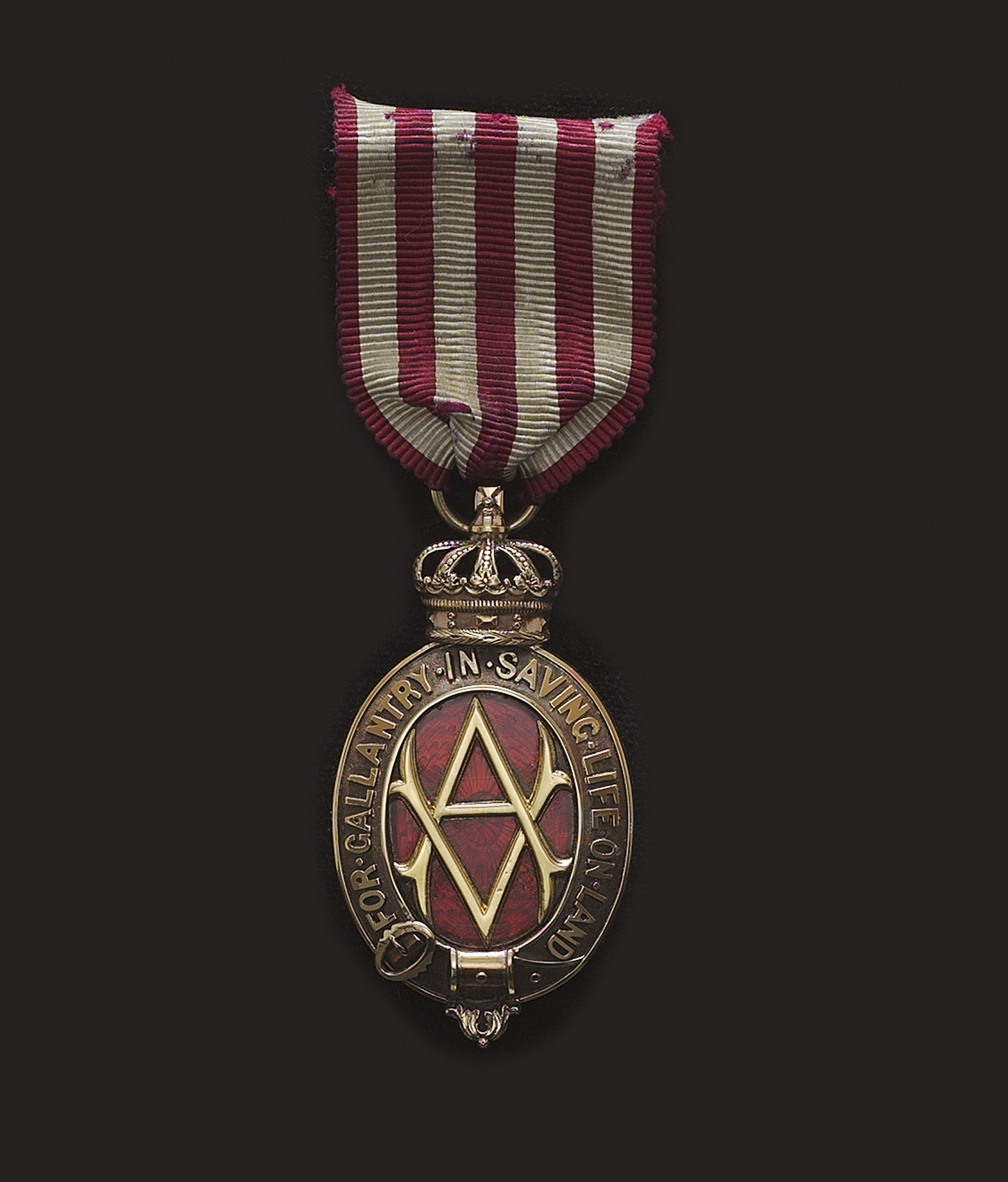 He joined the Metropolitan Police aged 20 on 8 October 1860, and left the force on 21 April 1886, with a police pension of £78 per annum for nervous shock caused by this incident. His medal is currently held in the collection of the House of Commons. The award was published in a London Gazette of 3 February 1885 (Gazette issue 25438).
He joined the Metropolitan Police aged 20 on 8 October 1860, and left the force on 21 April 1886, with a police pension of £78 per annum for nervous shock caused by this incident. His medal is currently held in the collection of the House of Commons. The award was published in a London Gazette of 3 February 1885 (Gazette issue 25438).
Pictured: the Albert Medal, awarded to PC William Cole, © Parliamentary Art Collection, WOA M0431
Chief Inspector Frederick Wright
Chief Inspector Frederick Wright was awarded the Albert Medal in Bronze for saving life on land in October 1917 when, during a Zeppelin raid, a bomb dropped on Camberwell, wrecking houses in Albany Road (Gazette issue 30668). He saved 13 people in dangerous and difficult conditions. Wright joined the Metropolitan Police on 4 February 1889 and posted to 4th (Chatham Dockyard) Division as PC 153 (warrant number 74225). After various postings, he retired as a chief inspector, age 51, on 5 February 1920, with a pension of £304, 7 shillings, 6 pence per annum.
Medal of the Most Excellent Order of the British Empire for Gallantry
This decoration was instituted at the same time as the Order of the British Empire (24 August 1917, Gazette supplement 30250). In 1922, it was substantially reformed (29 December 1922, Gazette issue 32781) when the Empire Gallantry Medal (EGM) and the British Empire Medal for Meritorious Service (BEM) were instituted.
The EGM was revoked by royal warrant on 24 September 1940 and 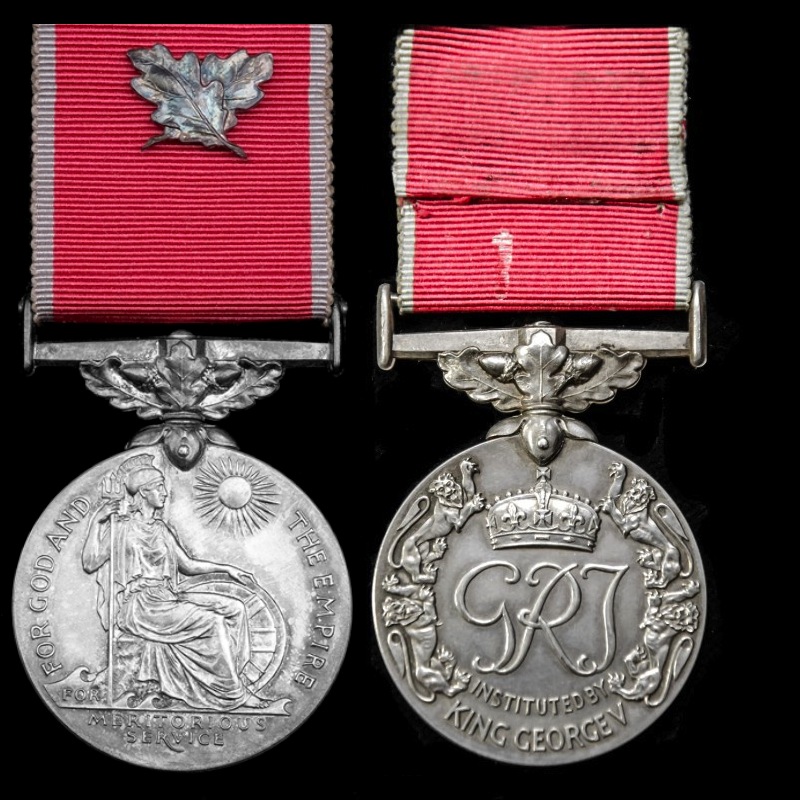 replaced with the George Cross. For a period between 1957 and 1974 – when it was replaced by the Queen's Gallantry Medal – the award for gallantry was distinguished by the wearing of two oak leaves on the ribbon. This medal was discontinued completely in 1993 (under the gallantry medals review led by John Major), and re-established in 2012 by David Cameron in honour of the Queen’s Diamond Jubilee – however, only for distinguished service.
replaced with the George Cross. For a period between 1957 and 1974 – when it was replaced by the Queen's Gallantry Medal – the award for gallantry was distinguished by the wearing of two oak leaves on the ribbon. This medal was discontinued completely in 1993 (under the gallantry medals review led by John Major), and re-established in 2012 by David Cameron in honour of the Queen’s Diamond Jubilee – however, only for distinguished service.
Pictured: the British Empire Medal, with emblem for gallantry. The reverse shows the cypher of King George VI. Obverse image courtesy of Dix Noonan Webb Ltd, reverse image courtesy of the London Medal Company Ltd
Police Constable Frederick Mark 'Rodney' Stone
For this award, we will focus on PC Frederick Mark 'Rodney' Stone GM KPM BEM (warrant number 111658), the most decorated officer for gallantry in the Metropolitan Police, awarded in 1941 for (along with other recognised colleagues) saving people buried in a building after it received a direct hit.
Supplement to the London Gazette of 8 August 1941 (Gazette supplement 35239):
‘A building was completely demolished by a high explosive bomb and people were trapped. Gas and water were escaping from fractured mains, the water rising rapidly in the basement. Foster at once took charge of the operations aided by Parker and Troman. Stone, who was off duty, also joined in the search. The officers found and successfully removed one casualty.
‘They then gradually tunnelled a way through towards the cellar, which they found flooded to a depth of four feet and littered with rubble. Sergeant Foster held up the slipping mass of debris to enable the others to work in greater safety. Owing to escaping gas the three Police Constables were able to work only in short spells, but managed to rescue three women.
‘A wall thirty feet high was damaged and likely to collapse and the officers were advised to leave the tunnel but refused to do so as two men were still missing. A careful but unsuccessful search was made and the officers left the tunnel just as the wall collapsed on to the site where they had been working.
‘The rescue work in extremely hazardous conditions lasted for two and a half hours. The courage and cool leadership displayed by Sergeant Foster and the bravery and perseverance of the Constables, resulted in the saving of four lives.’
During the course of Stone's service, he was awarded two Commissioner's Commendations and a Commissioner's 'High' Commendation, two awards from the Bow Street Reward Fund, an inscribed silver watch by the Carnegie Hero Trust, the bronze medal of the Royal Humane Society, the KPM for Gallantry, the BEM for Gallantry, the GM, and was also commended by the magistrates’ courts and the Central Criminal Court. He was in receipt of 'Maundy money' from the Queen, and was the subject of a BBC 'This is Your Life' programme in 1958.
King’s Police Medal (Queen’s Police Medal)
The King’s Police Medal was instituted by royal warrant by King Edward VII on 7 July 1909 (Gazette issue 28269), and was to be awarded to police officers and fireman for:
- Conspicuous gallantry in saving life and property, or in preventing crime or arresting criminals; the risks incurred to be estimated with due regard to the obligations and duties of the officer concerned.
- An especially distinguished record in administrative or detective service or other service of conspicuous merit.
- Success in organising police forces or fire brigades of departments, or in maintaining their organisation under special difficulties.
- Special services in dealing with serious outbreaks of crime or public disorder or of fire.
- Valuable political or secret services.
- Special services to royalty and heads of states.
- Prolonged service, but only when distinguished by very exceptional ability and merit.
The first award made (for distinguished service) was to Sir Edward Henry, commissioner of police for the Metropolitan Police (Gazette issue 28360), who when assistant commissioner, introduced the fingerprint system.
In 1933, the ribbon was changed when awarded for gallantry, to show two thin red stripes between the blue and white.
In 1932, the Home Office stated that the KPM, EGM or BEM could be awarded in cases of gallantry displayed by police officers. In 1951, a circular was published stating that the KPM for gallantry was to be replaced by the George Medal, and only awarded posthumously. It is still awarded for distinguished service.
The last Queen’s Police Medal was awarded to PC Stephen Tibble in 1976, after which it was superseded by the Queen’s Gallantry Medal. It is still awarded for distinguished service (for example, Gazette issue 61450).
Interestingly, the medal became known as the King’s Police and Fire Services Medal during World War 1 and retained this name until 1954, when the Queen’s Police Medal and the Queen’s Fire Service Medal were instituted. The royal warrant for the Queen’s Police Medal was published in The London Gazette on 4 June 1954 (Gazette issue 40196).
Police Constable Sidney Miles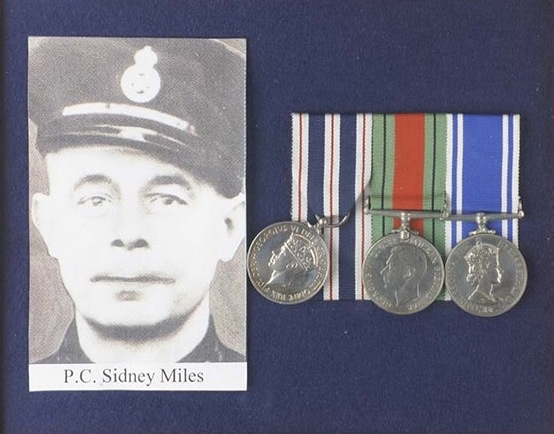
One such example of this award was to PC Sidney Miles. Miles was shot and killed on a warehouse rooftop in Croydon on 2 November 1952, when going to assist colleagues in the arrest of Christopher Craig and Derek Bentley.
For this action, Miles was awarded the KPFSM (Gallantry) in 1953 (Gazette issue 39747). His medals are held by the Metropolitan Police Crime Museum, having been donated in 1979. Awards for the same incident were also made to Frederick Fairfax (George Cross); Norman Harrison (George Medal); James McDonald (George Medal); and Robert Jaggs (British Empire Medal for Gallantry).
Pictured: the Kings Police and Fire Services Medal, Defence Medal, Police Long Service and Good Conduct Medal. Courtsey of the MPS Crime Museum, copyright of the Metropolitan Police Service
Queen's Gallantry Medal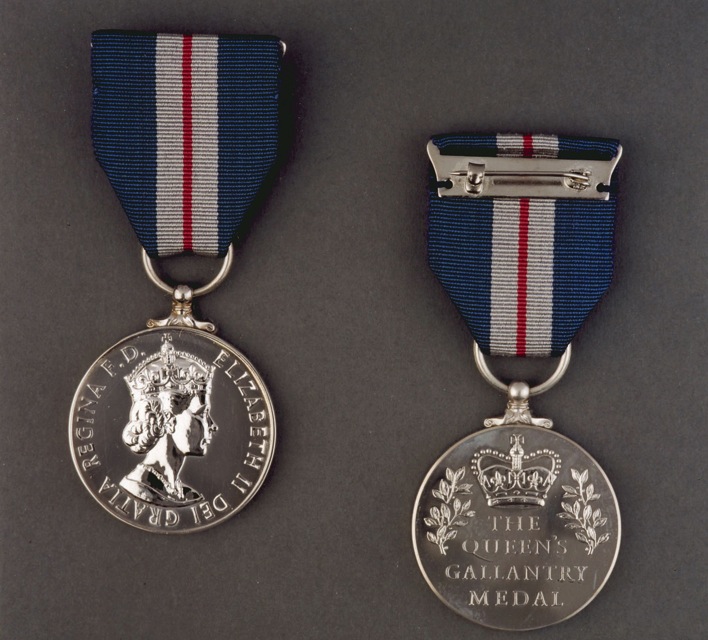
Replacing the Order of the British Empire for Gallantry, the BEM for Gallantry, and from 30 November 1977, the QPM for Gallantry (when awarded posthumously), the QGM is awarded for exemplary acts of gallantry, where the higher decoration of the GM is not suitable. The degree of risk of death is between 20 per cent and 50 per cent.
Pictured: the Queen’s Gallantry Medal. Crown copyright, reproduced under the Open Government License
Major Donald Henderson
A number of these awards were awarded to Metropolitan Police explosives officers in the 1980s, in respect of their gallant conduct when diffusing explosive devices during the IRA terrorist threat. A number of awards were also made to officers of the Metropolitan Police for tackling violent, and sometimes armed, persons. One such recipient was Major Don Henderson, an explosives officer with the Metropolitan Police, awarded in 1976 (Gazette supplement 47085):
‘On Monday, 13th October 1975, shortly after 9 p.m., two women who were walking past a block of flats noticed a black holdall wedged behind railings and against the window of a restaurant on the ground floor. One of the women went to the entrance of the flats and drew the night porter's attention to the bag. The porter immediately telephoned the police.
‘Two police officers in a patrol car were immediately sent to the scene and examined the hold-all and saw what appeared to be batteries with several sticks of explosives. They at once alerted the Information Room and set about evacuating fifty-five diners from the restaurant and clearing the street. By the time this had been done and the street cordoned, Major Henderson had quickly reached the area.
‘After a short briefing as to the suspected contents of the bag, Major Henderson immediately went to the device, opened the holdall and inspected the inside. It was at once evident that he was dealing with an extremely large high-explosive bomb which posed a very real danger both to him and the nearby residents who were still in their flats. He decided to attempt to neutralise the device and completed this both quickly and successfully as it turned out. When the timing device was examined, the modified pocket watch showed that only two minutes to detonation remained.
‘The device was found to contain 25Ibs. of high explosive with heavy metal coach screws, which on detonation would have been precipitated at high speed through the restaurant window, thereby causing heavy loss of life or serious injury to the diners, twenty of whom were seated at a table immediately inside the window against which the bomb had been planted. Major Henderson's achievement in preserving the device intact was also invaluable.
‘In defusing this bomb within minutes of its detonation, Major Henderson displayed outstanding gallantry, devotion to duty and a complete disregard for his personal safety.’
In his obituary in The Independent, he was said to be a quiet, reserved man who ‘spent much time verifying references in the London Gazette in the Public Record Office at Kew’. He died in 1999.
Queen’s Commendation for Brave Conduct (Bravery)
Although some civilians were commended for brave conduct previously, it was only in 1939 that commendations for civilians started to regularly appear in The London Gazette, once instituted by King George VI (for example, Gazette supplement 35258).
However, it wasn’t until 1943 that a badge was awarded (due to short supplies of plastic). Soon after the war (when supplies were a little more ample), the current emblem, a silver cluster of oak leaves, was adopted. The title was changed in 1953 to the Queen's Commendation for Brave Conduct and then in 1994 to the Queen's Commendation for Bravery. The degree of risk of death is generally below 20 per cent, when awarded.
Unlike all other gallantry awards, this is not governed by a royal warrant. The emblem is to be worn on the appropriate medal ribbon, or on the breast pocket. Awards are accompanied by a certificate which, for civilians, is signed by the prime minister.
The certificate reads: ‘By The Queen’s Order the name of [rank, name 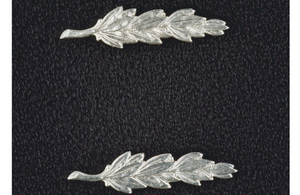 and force] was published in The London Gazette on [date of award] as Commended for Bravery…. I am charged to express Her Majesty’s high appreciation of the service rendered.’
and force] was published in The London Gazette on [date of award] as Commended for Bravery…. I am charged to express Her Majesty’s high appreciation of the service rendered.’
Pictured: Queen’s Commendation for Bravery/Brave Conduct. Crown copyright, reproduced the Open Government License
Police Long Service and Good Conduct Medal
In 1919, the commissioner proposed to the Home Office that there should be a medal for long service and good conduct for police (as for special constables).
The Home Office were of the opinion that this would have to be given to all forces, and as different forces had their own ways of keeping records of minor disciplinary offences, this wouldn’t work. After the 1918 police strike, and because the king had instituted many medals in recent years (as a result of World War 1), the matter was closed.
In 1934, the Home Office raised this matter to the commissioner, stating that His Majesty was considering instituting an award for colonial police, and that officers in this country should be considered. However, the Home Office thought that a medal should not be instituted just for long service and good conduct, and the commissioner agreed.
Nevertheless, opinion shifted, and King George VI issued a royal warrant instituting the award in 1951 (Gazette issue 59482).
About the author
Zeb Micic is a military and policing historian. He is currently editing the diary of an underage soldier, later serving as an officer in World War 1, and is curating an exhibition about Sir Ernest Shackleton. Zeb is a member of the Orders and Medals Research Society, Police History Society and the Metropolitan Police History Society.
For more information
- Abbot PE and Tamplin JMA, British Gallantry Awards, 1981 edn, London, Nimrod Dix and Co
- Gould RW, Journal of the Orders and Medals Research Society, Winter 1993 (Vol 32, No 4)
- History by the Yard, www.historybytheyard.co.ukHome Office Circulars 37/1997 (July 1997) and 77/1997 (December 1997)
- The National Archives, Kew, Surrey, www.nationalarchives.gov.ukThe Metropolitan Police Heritage Centre, West Brompton, London